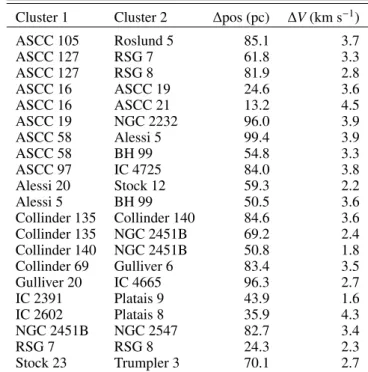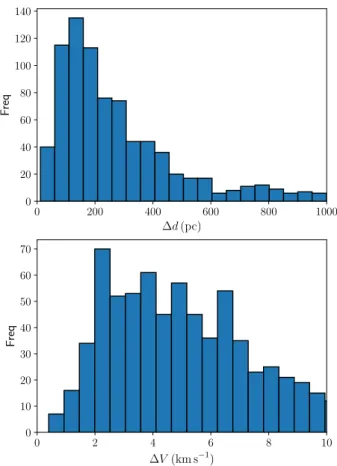HAL Id: hal-02079514
https://hal.archives-ouvertes.fr/hal-02079514
Submitted on 21 Aug 2020
HAL is a multi-disciplinary open access
archive for the deposit and dissemination of
sci-entific research documents, whether they are
pub-lished or not. The documents may come from
teaching and research institutions in France or
abroad, or from public or private research centers.
L’archive ouverte pluridisciplinaire HAL, est
destinée au dépôt et à la diffusion de documents
scientifiques de niveau recherche, publiés ou non,
émanant des établissements d’enseignement et de
recherche français ou étrangers, des laboratoires
publics ou privés.
Open cluster kinematics with Gaia DR2⋆ (Corrigendum)
C. Soubiran, T. Cantat-Gaudin, M. Romero-Gomez, L. Casamiquela, C. Jordi,
A. Vallenari, T. Antoja, L. Balaguer-Núñez, D. Bossini, A. Bragaglia, et al.
To cite this version:
C. Soubiran, T. Cantat-Gaudin, M. Romero-Gomez, L. Casamiquela, C. Jordi, et al.. Open cluster
kinematics with Gaia DR2⋆ (Corrigendum). Astronomy and Astrophysics - A&A, EDP Sciences, 2019,
623, pp.C2. �10.1051/0004-6361/201834020e�. �hal-02079514�
A&A 623, C2 (2019) https://doi.org/10.1051/0004-6361/201834020e c C. Soubiran et al. 2019
Astronomy
&
Astrophysics
Open cluster kinematics with Gaia DR2
?
(Corrigendum)
C. Soubiran
1, T. Cantat-Gaudin
2, M. Romero-Gómez
2, L. Casamiquela
1, C. Jordi
2, A. Vallenari
3, T. Antoja
2,
L. Balaguer-Núñez
2, D. Bossini
3, A. Bragaglia
4, R. Carrera
3, A. Castro-Ginard
2, F. Figueras
2, U. Heiter
6, D. Katz
7,
A. Krone-Martins
5, J.-F. Le Campion
1, A. Moitinho
5, and R. Sordo
31 Laboratoire d’Astrophysique de Bordeaux, Univ. Bordeaux, CNRS, B18N, allée Geoffroy Saint-Hilaire, 33615 Pessac, France e-mail: caroline.soubiran@u-bordeaux.fr
2 Institut de Ciències del Cosmos, Universitat de Barcelona (IEEC-UB), Martí i Franquès 1, 08028 Barcelona, Spain 3 INAF-Osservatorio Astronomico di Padova, vicolo Osservatorio 5, 35122 Padova, Italy
4 INAF-Osservatorio di Astrofisica e Scienza dello Spazio, via Gobetti 93/3, 40129 Bologna, Italy
5 CENTRA, Faculdade de Ciências, Universidade de Lisboa, Ed. C8, Campo Grande, 1749-016 Lisboa, Portugal 6 Department of Physics and Astronomy, Uppsala University, Box 516, 75120 Uppsala, Sweden
7 GEPI, Observatoire de Paris, Université PSL, CNRS, 5 Place Jules Janssen, 92190 Meudon, France A&A, 619, A155 (2018),https://doi.org/10.1051/0004-6361/201834020
Key words. stars: kinematics and dynamics – Galaxy: kinematics and dynamics – open clusters and associations: general – errata, addenda
Due to an unfortunate error in the computation of distance between clusters, Tables 4 and 5, and Fig. 12 in Sect. 3.3 of the original paper contain incorrect values. Here we present the updated tables and figure.
Table4gives the list of cluster pairs that differ by less than
100 pc in distance and 5 km s−1 in velocity in our high-quality sample. The closest pair includes ASCC 16 and ASCC 21, which are separated by ∼13 pc, with a velocity difference of 4.5 km s−1. RSG 7 and RSG 8, as well as ASCC 16 and ASCC 19, are also close pairs separated by ∼24 pc, with velocity differences of 2.3 km s−1 and 3.6 km s−1 respectively, thus good candi-dates to be physically related. Several possibly larger complexes may be found in that table, formed by clusters that appear more than one time. Table5 gives a list of candidates binaries from the literature. The most famous binary cluster formed by h and χ Persei (NGC 869 and NGC 884, Messow & Schorr 1913) appears to have a separation of 19.5 pc. An excellent candidate binary is the pair Collinder 394 and NGC 6716, which lie at a distance of ∼11 pc from each other. IC 2602 and Platais 8 are also close from each other (∼35 pc) and they are possibly phys-ically related, owing to their common age in DAML and similar velocity (also reported in Table 4). The other pairs in Table5
have much larger separation and they are more likely to result from a chance alignment than that they are a physical binary system.
? The table with clusters velocities is only available at the CDS via anonymous ftp tocdsarc.u-strasbg.fr(130.79.128.5) or via
http://cdsarc.u-strasbg.fr/viz-bin/qcat?J/A+A/623/C2
Table 4. Pairs of OCs differing by less than 100 pc in their Galactic position and 5 km s−1in velocity in the high-quality sample.
Cluster 1 Cluster 2 ∆pos (pc) ∆V (km s−1)
ASCC 105 Roslund 5 85.1 3.7 ASCC 127 RSG 7 61.8 3.3 ASCC 127 RSG 8 81.9 2.8 ASCC 16 ASCC 19 24.6 3.6 ASCC 16 ASCC 21 13.2 4.5 ASCC 19 NGC 2232 96.0 3.9 ASCC 58 Alessi 5 99.4 3.9 ASCC 58 BH 99 54.8 3.3 ASCC 97 IC 4725 84.0 3.8 Alessi 20 Stock 12 59.3 2.2 Alessi 5 BH 99 50.5 3.6 Collinder 135 Collinder 140 84.6 3.6 Collinder 135 NGC 2451B 69.2 2.4 Collinder 140 NGC 2451B 50.8 1.8 Collinder 69 Gulliver 6 83.4 3.5 Gulliver 20 IC 4665 96.3 2.7 IC 2391 Platais 9 43.9 1.6 IC 2602 Platais 8 35.9 4.3 NGC 2451B NGC 2547 82.7 3.4 RSG 7 RSG 8 24.3 2.3 Stock 23 Trumpler 3 70.1 2.7
Open Access article,published by EDP Sciences, under the terms of the Creative Commons Attribution License (http://creativecommons.org/licenses/by/4.0), which permits unrestricted use, distribution, and reproduction in any medium, provided the original work is properly cited.
A&A 623, C2 (2019) 0 200 400 600 800 1000 ∆d (pc) 0 20 40 60 80 100 120 140 F req 0 2 4 6 8 10 ∆V (km s−1) 0 10 20 30 40 50 60 70 F req
Fig. 12.Histogram of the distance between nearest neighbours in the high-quality sample (upper panel) and the same in velocity (lower panel).
Table 5. Separation in space and velocity of binary candidates from the literature, computed from our mean parameters for 861 OCs.
Cluster 1 Cluster 2 ref ∆pos (pc) ∆V (km s−1)
Alessi 13 Mamajek 1 1 92.5 5.1 Alessi 21 NGC 2422 1 120.8 9.3 Platais 8 IC 2602 1 35.9 4.3 Turner 9 ASCC 110 1 275.6 9.0 Collinder 394 NGC 6716 1 11.4 13.8 IC 1396 NGC 7160 1 87.6 13.9 NGC 869 NGC 884 2 19.5 19.9 NGC 5617 Trumpler 22 3 79.8 10.4 IC 4756 NGC 6633 4 82.9 8.0
References. (1) Conrad et al. (2017), (2) Messow & Schorr (1913), (3)De Silva et al.(2015), (4)Casamiquela et al.(2016).
References
Casamiquela, L., Carrera, R., Jordi, C., et al. 2016,MNRAS, 458, 3150 Conrad, C., Scholz, R.-D., Kharchenko, N. V., et al. 2017,A&A, 600, A106 De Silva, G. M., Carraro, G., D’Orazi, V., et al. 2015,MNRAS, 453, 106 Messow, B., & Schorr, R. R. E. 1913, Astronomische Abhandlungen der
Hamburger Sternwarte, 2, 1

